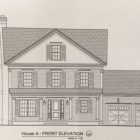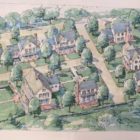News
Hopeful Developer of Roger Sherman Site Proposes New Zone for Regulations To Make Project Possible
|
Seeking to tweak the New Canaan Zoning Regulations in a way that will make his plans possible, the would-be developer of the Roger Sherman Inn on Monday filed a new application that proposes a so-called “overlay district.”
Filed on behalf of Norwalk developer Andrew Glazer and Glazer Group, the proposed district would allow him to convert part of the existing inn into a residence and build another six 2.5-story, 2,600-square-foot units on the 1.8-acre lot at 195 Oenoke Ridge Road. Located in the 1-acre zone with a 96-foot easement that runs east of the parcel, the property could accommodate a single home under the existing regulations. Glazer in an initial application made in September and at a subsequent public hearing last month argued that his plan would bring the property into greater conformity with the regulations because it would be a non-commercial use. Filed by Westport-based engineering firm Landtech—not by an attorney who specializes in land use matters, as typically is done—the proposed ‘Non-Conforming Residential Overlay District’ “would allow existing non-conforming uses to be replaced by a more conforming uses.”
“The proposed amendment is a precursor to our special permit application for the proposed residential development of the Roger Sherman Inn,” Landtech principal Peter Romano said in the Nov. 14 application.



